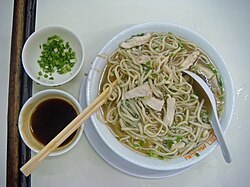 Chicken mami of Masuki restaurant | |
| Type | Soup |
|---|---|
| Course | Main course |
| Place of origin | Philippines |
| Region or state | Binondo, Manila |
| Created by | Ma Mon Luk |
| Invented | 1920 |
| Main ingredients | |
Mami (pronounced: MAH-mee) is a popular Filipino noodle soup made with wheat flour noodles, broth and the addition of meat (chicken, beef, pork) or wonton dumplings. It is related to the pancit class of noodle dishes, and the noodles themselves are sometimes called pancit mami.
Origin and etymology[edit]
Its creation is generally attributed to Ma Mon Luk, a Chinese immigrant to the Philippines who began selling noodles served with chicken broth and chicken meat in Binondo, Manila in 1920. He originally worked as an ambulant vendor, carrying the food in two metal vats on a pole much like taho vendors. Thus, mami was originally street food, but with the success of his business, Ma eventually opened up an eatery and ultimately a chain of restaurants bearing his name. As a street vendor, Ma originally called his dish "gupit", after the Tagalog word for “cut”, because he would cut the noodles and chicken with scissors. He later decided to call the dish "Ma mi" (simplified Chinese: 马面; traditional Chinese: 馬麵; Cantonese Yale: Máh-mihn; Pe̍h-ōe-jī: Má-mī; lit. 'Ma’s noodles'). However, Ma did not have the name trademarked. Soon, imitation noodle soups sprouted with a name that was, personally, his.[1][2][3][4]
Alternately, mami is thought to come from manok (chicken) and miki (a type of noodle).[1] This is supported by beef or pork mami sometimes being known as bami, from baboy' (pork/pig) or baka (beef/cow).
Regardless, the claim that Ma "invented" mami, both the dish itself and the term, is likely untrue. According to linguist Gloria Chan-Yap, mami is Fujianese in origin, not Cantonese; in Philippine Hokkien literally means "meat noodles" (simplified Chinese: 肉面; traditional Chinese: 肉麵; Pe̍h-ōe-jī: Mah-mī). Like the siopao, the noodle dish already existed in Filipino-Chinese cuisine before Ma popularized his version.[5]
See also[edit]
References[edit]
- ^ a b Cordero-Fernando, Gilda (1978). "The Mami King". In Roces, Alfredo (ed.). Filipino Heritage: The Making of a Nation. Vol. 10. Manila: Lahing Pilipino Publishing Inc. pp. 2592–95.
- ^ Gao Min Chuan, The Story of Mami King, Ma Mon Luk Archived December 8, 2015, at the Wayback Machine, Zhongshan Overseas Chinese Journal, April 1, 2010
- ^ Rodriguez, Anna Katarina (2012). Southeast Asian Personalities of Chinese Descent: A Biographical Dictionary, Volume 1. Singapore: Institute of Southeast Asian Studies. pp. 736–738. ISBN 978-981-4345-21-7.
- ^ Jose Victor Z. Torres, The Legend of Ma Mon Luk, Rogue, April 2017
- ^ De Leon, Adrian (2016). "Siopao and Power: The Place of Pork Buns in Manila's Chinese History". Gastronomica. 16 (2): 45–54. doi:10.1525/gfc.2016.16.2.45. JSTOR 26362345.

Well, that’s interesting to know that Psilotum nudum are known as whisk ferns. Psilotum nudum is the commoner species of the two. While the P. flaccidum is a rare species and is found in the tropical islands. Both the species are usually epiphytic in habit and grow upon tree ferns. These species may also be terrestrial and grow in humus or in the crevices of the rocks.
View the detailed Guide of Psilotum nudum: Detailed Study Of Psilotum Nudum (Whisk Fern), Classification, Anatomy, Reproduction